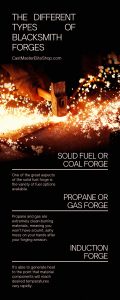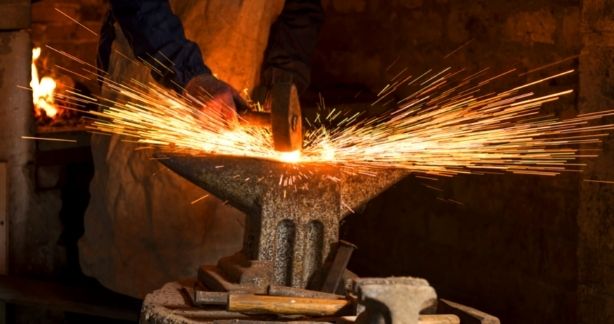Whether you’re a new blacksmith searching for your first forge or a veteran looking to add a new forge to the shop, it’s important to know the ins and outs of your desired forge before you invest. Blacksmithing equipment doesn’t run cheap, so take this opportunity to read up on the different types of blacksmithing forges before you shop around.
The Three Major Types of Forges
There are three major types of modern blacksmithing forges: solid fuel, gas, and induction forges. Each type of forge has different uses, benefits, fuel sources, and requirements. Knowing this, let’s take a deep dive into the three types of forges, the differences between them, and which one you might want to use in your own blacksmithing shop.
Solid Fuel or Coal Forge
The solid fuel forge is what most people think of when they think of blacksmithing. This version of the forge requires a steady burning material, such as charcoal, coal, wood, or coke (a hard carbon fuel). The solid fuel forge is the more traditional version of the forge. This makes it one of the most trustworthy forges you can find, as it has stood the test of time in the industry.
Benefits
One of the great aspects of the solid fuel forge is the variety of fuel options available. Coal is one of the more popular options because it burns slowly and more efficiently, which is ideal for longer projects. However, some blacksmiths prefer charcoal or wood because these materials burn more quickly. Coal typically burns the hottest of them all, so if you’re looking to work with metals with high melting points, a coal solid fuel forge is ideal for you.
Propane or Gas Forge
The propane forge is a modern version of the traditional blacksmithing forge. Many folks in the blacksmithing community consider the propane or gas forge to be the perfect choice for beginners to the craft. This is because of its overall ease of use. All you need to fuel a gas forge is a propane tank, as opposed to the pile of coal or charcoal you’d need for the solid fuel forge. However, blacksmiths recommend having an extra propane tank or two on hand whenever you start a new project, as gas forges tend to burn through fuel faster than the traditional method. If you plan to build your own forge from scratch, you’ll also need some extra equipment and tools for building a propane burner. Otherwise, these forges are extremely beginner friendly, and they have many benefits.
Benefits
The benefits of using this forge stem from its fuel source. Propane and gas are extremely clean-burning materials, meaning you won’t have a burnt, ashy mess on your hands after your forging session. And although you do have to stock up on propane tanks before your burn, these tanks are very easy to find at almost any hardware store. Even lighting a propane forge is easy for beginners—all you have to do is open the gas valve and place the burner in your foundry.
Propane also supplies a steady stream of fuel and heat, which leaves the chamber heated evenly so that you don’t have to focus your work on one area. Overall, there’s plenty of benefits to using a gas forge, whether you’re a newbie or a veteran blacksmith. If you’re sold on the idea of this forge, you can check out a variety of gas blacksmith forges for sale over at Cast Master Elite.
Induction Forge
The induction forge is the lesser known of the different types of blacksmith forges, although it still has its place in the lineup. In fact, it’s popular in many modern foundries, alongside the gas forge. The induction forge uses electricity to heat and melt metals and alloys, and—like the gas forge—it burns very cleanly. Not much cleanup is required for the induction forge, either. Because it’s electrically powered, you can easily control and contain this method.
Induction forges specialize in billet heating, bar end heating, deformation, and several other processes. Some of the materials blacksmiths commonly melt in the induction forge are cast iron, steel, copper, aluminum, and even some precious metals.
Benefits
One of the most impressive things about the induction forge is its ability to heat up very quickly. It’s able to generate heat to the point that material components will reach desired temperatures very rapidly. This forge is very energy efficient as well, providing a contained and consistent heat. Like the propane forge, the temperature it produces is very evenly distributed throughout the entire chamber. These forges are also great for both beginner and expert blacksmiths, though they can be pricey investments. For this reason, solid fuel or gas options may be better for hobbyist blacksmiths.
Best Forge for the Job
All these types of forges have their own unique features, purposes, and jobs. You can melt most of the common working materials and alloys in any of the above options, but some forges burn hotter than others. For example, if you want to work with metals that have particularly high melting points, you may want to choose the coal or solid fuel forge. These forges burn the hottest, at around 3,500 degrees Fahrenheit, followed by propane, charcoal, and wood. Consider the types of metals you want to work with first and see which forge would be most compatible before you commit. Whether you’re a beginner or expert, the most important thing is that your forge matches your goals as a blacksmith. Some blacksmiths will even choose to construct their own forges from scratch to meet their shops’ unique needs.
Have you made your decision on which type of forge is best for you? We hope this breakdown of the different benefits of each type has helped you decide which would be best for your needs. Sometimes we all need a refresher course on the different tools of the trade. So, keep these benefits in mind while you’re shopping around for your next forge.







